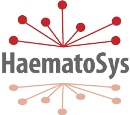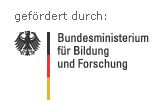HaematoSys
Systembiologie der Hämatopoese und hämatopoetischer Neoplasien
Subproject 3: Evolution of t(14;18)-positive lymphomas ¿ Longitudinal Data Acquisition and Modelling
Coordinator: Reiner Siebert
Responsible scientists: Ralf Küppers (RK), Wolfram Klapper (WK), Markus Löffler (ML), Christiane Pott (CP), Reiner Siebert (RS)
Associated partners: M Dreyling, (GLSG), M Pfreundschuh (DSHNHL), L Trümper (MMML)
Background and own contributions: The t(14;18)(q32;q21) leading to juxtaposition of immunoglobulin (IG) genes to the BCL2 gene is the most frequent chromosomal translocation in lymphomas present in 80-90% of follicular lymphomas (FL) and 20-30% of diffuse large B-cell lymphomas (DLBCL) accounting for 2/3 of all NHL in Germany. With present therapies, cure can be achieved in 2 of 3 patients with DLBCL and rarely in FL. Around 3% of FL per year transform into secondary and aggressive DLBCL. The factors leading to relapse, transformation or therapy resistance in t(14;18)-positive lymphomas are unknown. The t(14;18) can also be detected in the peripheral blood of up to 70% of healthy individuals by highly sensitive PCR. It is currently assumed that the t(14;18) occurs in a precursor B-cell in the bone marrow and migrates to a lymph node germinal centers (GC) where the clone expands and differentiates. In the highly mutagenic GC environment, malignant transformation probably takes place through acquisition of secondary genetic changes changing functional and regulatory features of the cells. Clinical relapse and transformation can derive from the initial lymphoma clone or from clonal decendents. There is only few data on clonal evolution and the impact of functionally relevant mutations for competitive advantages of malignant cells in the germinal center reaction (GCR). We plan to gather a novel and unique set of longitudinal data on clonal evolution and functional features of relapsing t(14,18)-positive lymphomas. This will provide a unique data set for modelling tumour evolution and providing insight into the mechanisms generating the diversity of disease mentioned above. We will use an IBM similar to the model used for describing HSC (WP1/SP1) and CML (WP2), however, adapting to the specificities of the GCR and the microenvironment found there. We will use results obtained in available models on the normal 2-3 week GCR [3.46] but we will develop a novel class of models accounting for the long time scales (months-years) and permitting tracking of clones (measured by the mutations in the IG-genes) and accumulation of functional mutations. The experimental partners of this SP have significantly contributed to the current understanding of B-cell development in normal and pathological GC, the histopathologic, cytogenetic, molecular genetic and epigenetic characterization of FL/DLBCL as well as the clinical management of t(14;18)-positive lymphomas and DLBCL. They characterised genetic changes and cytogenetic evolution pathways in FL, delineated the extensive migration of FL cells among follicles, provided evidence that FL depend on the follicular microenvironment for their clonal expansion, described a GC-B-cell precursor common to FL and Hodgkin lymphoma in composite lymphomas, and identified a DNA-methylation pattern in GC-lymphomas pointing to a polycomb complexmediated stem cell memory. The modelling partner has made major contributions for the understanding of the profiling studies in DLBCL and has extensive experience in modelling regenerative tissues Objective: We aim at developing a dynamic model of the clonal evolution of t(14;18)-positive lymphomas. The model will consider the clonal evolution of normal and premalignant t(14;18)+ B-cells entering the GCR and the functional consequences of somatic hypermutation of the immunoglobulin-heavy chain locus as well as non-IG genes resulting from the action of somatic hypermutation in the GC on proliferation, apoptosis control, differentiation and dependency on the FDC/T-cell micro-environment. The model will permit to study clonal competition of normal Medical Systems Biology / HaematoSys page 94 and t(14;18)+ cell clones in the GC and shall cover temporal aspects of clonal composition at all stages of tumour evolution, from the occurrence of the initiating t(14;18) in a stem cell (preB) in the bone marrow, over expansion of t(14;18)-positive differentiated B-cells and malignant transformation in the GC up to systemically relapsing lymphoma and clonal progression to therapyresistant disease. The model will link phenotypic properties of lymphoma immunohistochemistry with genetic data particularly measured in synchronous or longitudinal pairs or triples of relapsing FL-tumours (genomic copy number changes, chromosomal translocations, mutations of IG- and non-IG genes, epigenetic changes).
Available data: Extensive datasets from conventional cytogenetics [3.33], array CGH and gene expression analyses, array-based DNA-methylation profiling (MMML) and IGHV and in part BCL6 mutation analyses [3.45]; A considerable number of cases analysed for several or even all of these features (77 FL, 54 t(14;18)+ DLBCL); Publicly available cytogenetic (Mitelman database) and array-based datasets (GEO); Genomic and gene expression profiling data of at least 350 t(14;18)-positive lymphomas (mostly from the MMML and LLMPP profiling projects); Clinical data from the study centers of the German Low Grade (MD) and High Grade (MP) Lymphoma Study Groups; The project takes advantage from the fact that the partners run pathologic (WK), molecular (CP) and cytogenetic (RS) reference labs of the German Low Grade Lymphoma Study Group.
Work program:
Experimental work. The experimental part of this SP is to complement the available data with a longitudinal study in patients with relapsing FL. Fresh frozen material of two or more simultaneous and/or subsequent lymph node biopsies with FL will be examined from 50-70 patients already available (time between initial and subsequent biopsies 0 up to 9 years). Moreover, two or more (median: 3) repetitive peripheral blood or bone marrow samples are available from 260 patients with FL, in which the clonal IGH rearrangement is already characterised. Based on established protocols and interactions between the partners, histopathologic characteristics (IHC on TMAs), chromosomal translocations (FISH), genomic imbalances and UPD (SNP-Chip), DNAmethylation (array-based and pyrosequencing) and (ongoing) IGHV hypermutation (cloning/sequencing) shall be analysed. Moreover, the impact of somatic mutation of various non-IGgenes (TP53, BCL6, MYC, etc.) involved in clonal evolution will be determined by custom indepth next-generation-sequencing. Similar, in selected non-malignant and FL cases in-depth sequencing of IG and non-IG genes shall be performed on microdissected neoplastic and nonneoplastic follicles from various biopsies and leukemic disease to analyse normal and neoplastic migration of GC cells. Tissue microarrays will be prepared and stained with over 30 antibodies to assess the activities and the local spread and density of the functional cell status in the normal and diseased tissues implying analysis of digitalised images.
Bioinformatic Data Analysis. Data from available and newly obtained histopathologic, genetic, epigenetic and clinical characteristics, the phenotypic features of the single clones (proliferation, growth velocity, apoptotic activity, follicular versus diffuse growth type), the number, size and descendence of clones over time (to be related to IGHV and other gene mutation patterns), the measure of complexity of cumulated genomic or epigenomic mutations (to be related to chromosomal imbalances, UPD, gene mutations, chromosomal translocations, DNA methylation) and the degree of stemness (to be related to DNA-methylation, mutation and IHC data) will be collected in a central database in Leipzig (see WP4). Initial analyses and interpretation of the highdimensional genomic, epigenomic, IHC, morphometric and clinical data will be performed. Preanalysed data are then provided for modelling in such a way that they can readily be used for the dynamical model.
Dynamic Model: Based on the experience in modelling HSC and CML (see WP1, WP2) in the group of ML we will develop an IBM of the human GCR on and its malignant variants. The model accounts for the IG affinity maturation and associated cell proliferation, differentiation and Medical Systems Biology / HaematoSys page 95 apoptosis. Constraining the reaction to the GC-microenvironment (FDC, T-cells) will induce strong clonal selection. Consideration of somatic hypermutation of the IG gene in B-cells will generate clonal labels in all cells which can be used for clone tracking. In addition, mutation related parameter changes (related to functional gene mutations beyond IG-genes) are considered at a low frequency. Model readouts will be mapped to the novel longitudinal data regarding tumour cell features (histological phenotype, growth pattern, proliferation, and apoptosis), type, frequency and complexity of functional mutations, clonal evolution in the IG-genes, and related changes at progression of the tumour. The drift of clones within the parameter space of proliferation, apoptosis, differentiation and GC-niche formation will be linked to the observed molecular alterations. Observational data from clinical trials of the GLSG and DSHNHL study groups on outcome rate and typical time scales will be used to adjust the kinetic parameters of the model. The model will benefit also from the results in SP2 of this WP and from modelling in WP1 and WP2.
Achievements expected: The modelling will provide particular insight into how somatic mutations accumulate and how they are driving lymphomagenesis producing a remarkable heterogeneity of individual tumours and of types of tumours (FL, DLBCL) with different treatment outcomes. This model might lead to a novel understanding of the pedigree of lymphomas. The model will provide novel diagnostic strategies and will help to design optimised treatment protocols to be further tested in clinical trials.

